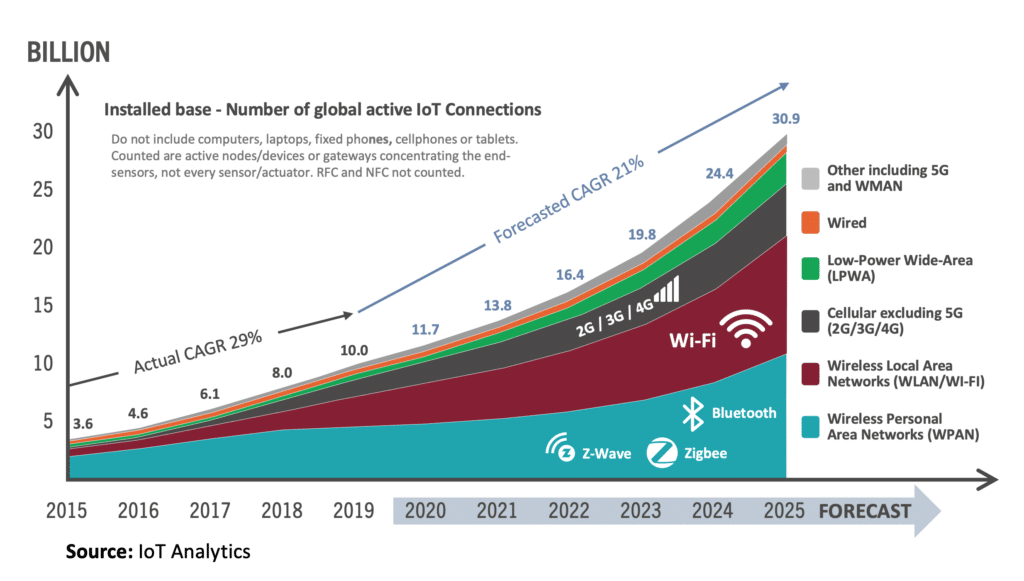One-third of all IoT
Wi-Fi-based IoT
There is currently a hype around cellular IoT, especially with the new opportunities that 5G will bring. And it is not without cause; 5G will bring new real-time critical communication opportunities in industries such as automotive and remote surgery.
But a lesser-known fact is that around 70% of all IoT devices are connected through short-range technologies such as Bluetooth, Wi-Fi, Zigbee, and Z-wave. And at least one-third of all IoT devices connect through Wi-Fi.
Wi-Fi in the 5G era – White Paper
This is an excerpt from our white paper Wi-Fi in the 5G Era – Strategy Guide for Operators. The full white paper is available here if you like what you read. Don’t hesitate to contact us if you have any questions.

The Challenges of
Connecting Billions of Wi-Fi IoT Devices

The opportunity for operators to deliver connectivity services for IoT devices has long been touted as one of the most important growth segments in telecom. And the number of wireless IoT devices in need of connectivity is indeed growing at an impressive rate. As shown in the figure, IoT Analytics forecasts growth of the installed base from 10.0 billion in 2019 to 30.9 billion in 2025. Ericsson’s slightly more conservative estimate predicts growth from 12.6 billion units in 2020 to a whopping 26.9 billion in 2026.
But here is a perhaps lesser-known fact: By far the largest proportion of IoT devices – approximately 7.5 billion out of a total of 11.7 billion units as of 2020, to be exact, see the figure above – are short-range, non-cellular devices. And as mentioned, according to IoT Analytics, Wi-Fi-based IoT devices represent a third of all IoT devices in 2020 and are one of the fastest-growing tech product segments.
The number of Wi-Fi-based IoT devices is expected to increase to more than 7 billion by 2025. This number, of course, includes devices for the smart home, devices operated by businesses, and even machinery and automation-type devices for industrial applications.
Connecting billions of IoT devices with secure and reliable carrier-grade Wi-Fi services is clearly a big business opportunity. But it is also a significant challenge for any service provider because the IoT device market is notoriously fragmented and dominated by proprietary solutions.
Onboarding Must Be As Seamless and Secure As Cellular IoT
The secure and automatic onboarding of masses of IoT Wi-Fi devices – many of which are ‘headless’ without a user interface – has proven less than easy.
Thankfully there are new initiatives that allow service providers to achieve effective automatic onboarding. Enea’s Zero-Touch Wi-Fi IoT Connectivity concepts use certificates (x.509) that already exist in devices to auto-connect Wi-Fi IoT devices to Wi-Fi right out of the box. We have partnered with Amazon Web Services (AWS) IoT Core to deliver an end-to-end, massively scalable Wi-Fi IoT onboarding proof of concept.
There is only one important puzzle piece missing for a mass market. The device must from factory try to connect to a “ZeroTouch” Hotspot 2.0 service or legacy ZeroTouch SSID.
The Zero-touch concept also lends itself well to the WBA OpenRoaming, described in a recent insights post. In this case, the OpenRoaming mechanisms could also be used for the Zero-touch concept. Different players could act as an ‘identity provider’ for IoT devices, allowing any enterprise, IoT solution provider, or operator to sign up for the service. The end result would be the onboarding and auto-connection of IoT devices not only within their own network but also within the extended coverage footprint enabled by the OpenRoaming federation.
Because we encourage the industry to participate in this initiative, we have chosen not to patent the Zero-Touch innovation. We believe that the time is now for operators to invest in massively scalable and standardized onboarding for Wi-Fi IoT.
What is clear, is that the seamless and secure onboarding of IoT Wi-Fi devices must be solved, one way or another.
Cellular and IoT
Unified IoT Connectivity Control
With the Enea Aptilo IoT Connectivity Control Service™ (IoT CCS), mobile operators get a hyperscale programmable layer for cellular IoT connectivity control, security, and automation. The IoT CCS service features next-generation firewalls from Fortinet so operators can offer managed security with individual settings for each IoT customer. Nothing technically stops us from adding support for other radio technologies, such as Wi-Fi, to the IoT CCS service. This would enable service providers to offer a unified IoT connectivity service with the same policy control and security level over both cellular and Wi-Fi. In this Wi-Fi Now article, our Jonas Björklund further elaborates on the vision of a unified connectivity control delivered from the Cloud.




